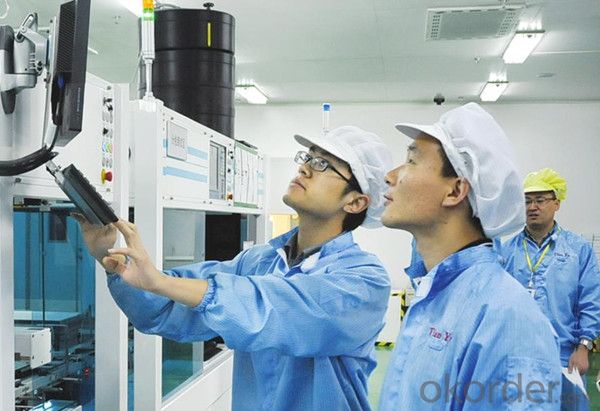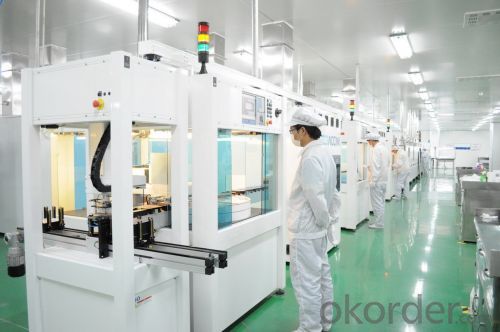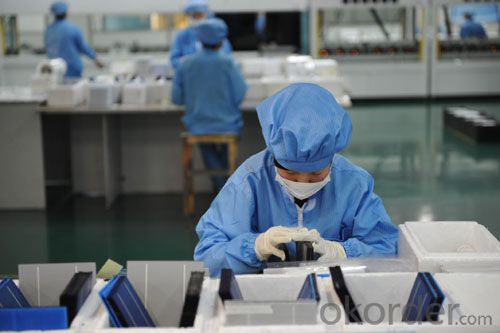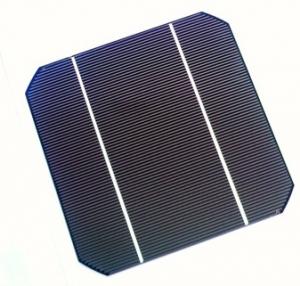Monocrystalline 3d Solar Cells-Tire manufacturers from China
- Loading Port:
- Shanghai
- Payment Terms:
- TT or LC
- Min Order Qty:
- 10000 pc
- Supply Capability:
- 50000000 pc/month
OKorder Service Pledge
OKorder Financial Service
You Might Also Like
Specifications of Mono Solar Cells
Format : 156 mm × 156 mm ± 0.5 mm
Thickness: 210 μm ±40 μm
Front (-) : 1.5mm bus bars (silver),blue anti-reflection coating (silicon nitride)
Back (+) : 2.5mm wide soldering pads (silver) back surface field (aluminium)
Electrical Characteristic of Mono Solar Cells
Efficiency (%) | Pmpp (W) | Umpp (V) | Impp (A) | Uoc (V) | Isc (A) | FF (%) |
18.35 | 4.384 | 0.526 | 8.333 | 0.63 | 8.877 | 78.39% |
18.20 | 4.349 | 0.526 | 8.263 | 0.63 | 8.789 | 78.54% |
18.05 | 4.313 | 0.525 | 8.216 | 0.63 | 8.741 | 78.32% |
17.90 | 4.277 | 0.524 | 8.161 | 0.629 | 8.713 | 78.04% |
17.75 | 4.241 | 0.523 | 8.116 | 0.629 | 8.678 | 77.70% |
17.60 | 4.206 | 0.521 | 8.073 | 0.628 | 8.657 | 77.36% |
17.45 | 4.170 | 0.519 | 8.039 | 0.628 | 8.633 | 76.92% |
17.30 | 4.134 | 0.517 | 8.004 | 0.626 | 8.622 | 76.59% |
17.15 | 4.098 | 0.516 | 7.938 | 0.625 | 8.537 | 76.80% |
17.00 | 4.062 | 0.512 | 7.933 | 0.625 | 8.531 | 76.18% |
16.75 | 4.002 | 0.511 | 7.828 | 0.625 | 8.499 | 75.34% |
16.50 | 3.943 | 0.510 | 7.731 | 0.625 | 8.484 | 74.36% |
Advantage of Mono Solar Cells
1. High efficiency and High power.
2. Long-term electrical stability.
3. Lowest price and Fastest delivery.
4. Good quality and best service.
5. Bulk supply
6. Trusted Warranty
7. Big Sale
8. More than 25 years on the lifetime.
Usage and Applications of Mono Solar Cells
Solar cells are often electrically connected and encapsulated as a module. Photovoltaic modules often have a sheet of glass on the front (sun up) side, allowing light to pass while protecting the semiconductor wafers from abrasion and impact due to wind-driven debris, rain, hail, etc. Solar cells are also usually connected in series in modules, creating an additive voltage. Connecting cells in parallel will yield a higher current;our solar cells have passed IEC Certification. With high quality and stable quality. Our Cells can greatly improve the performance of Solar Modules.
Packaging & Delivery of Mono Solar Cells
Carton Box Package and Deliver by air. It should be noticed that it should be avoid of water, sunshine and moist.
Factory Picture of Solar Cells



FAQ
We have organized several common questions for our clients,may help you sincerely:
A: It’s depends on the quantity, delivery date and payment terms of the order. We can talk further about the detail price issue. Our products is high quality with lower price level.
We have different series of cells with different power output, both from c-si to a-si. Please take our specification sheet for your reference.
We have rich experience on how to pack the panels to make sure the safety on shipment when it arrives at the destination.
Yes, we can.
In the purchase of product within three working days, We will arrange the factory delivery as soon as possible. The perfect time of receiving is related to the state and position of customers. Commonly 7 to 10 working days can be served.
Rumors about 3d solar cell manufacturers
Whether all 3d solar cell manufacturers are at a loss?
Truth: Some 3d solar cell manufacturers at a loss, but not all are so. Many silicon solar cell manufacturers with the same technology in the same field of competition, leading them the more difficult situation. Other areas are more profitable, such as films, elastic and lightweight solar panels fields.
With the rapid changes in business and market leadership, the 3d solar cell industry is still immature. Today we see is a traditional period of consolidation of a new industry, there are winners and losers, but the surviving players will usher in a bright and lucrative future.
In the next winner, there will be those companies of the roof and the building, because they insight into BIPV must be a rising star. Solar cells will be better integrated into the roofs and facades. The current building materials manufacturers in this field will gain market-share opportunity.
Prospects of 3d solar cell manufacturers
Solar is already a highly cost-competitive energy. Cheap, efficient batteries will certainly enhance the attractiveness, but in fact, the most abundant solar energy in sunlight, when the production of electricity, which makes it less dependent on energy compared to other energy storage solutions. In the long run, with the improvement of solar cell manufacturing technology and new light - electric conversion means the protection of inventions, national environmental and regeneration of the huge demand for clean energy, solar cells will continue to use solar radiation more practical and feasible the method can open up broad prospects for large-scale use of solar energy for the human future.
2009-2013, China's 3d solar cell production increased year by year, in which the Chinese solar cell production in 2010 increased by 117.04%, the largest increase in recent years; in 2012, China's solar cell production growth decline, only 14.11%; 2013 China cell production further expand the scale, capacity of 42GW, production reached 25.1GW. Compared with 2012, the growth rate of about 20%, production accounts for about 62% of the global total, ranking first in the world. At present, China has become the world's leading producer of 3d solar cells.
China has already overtaken Europe, Japan, being the largest world's solar cell manufacturing superpower. In the industrial layout, China's 3d solar cell industry has formed a certain gathering momentum. In the Yangtze River Delta, the Bohai Sea, the Pearl River Delta, Midwest, it has formed a unique solar energy industry cluster. By 2030, it is possible to achieve the cost of solar power down to the level of wind power.
- Q:How can I understand the working principles of solar cells?
- All in all, the working principle of a solar cell can be understood in this way, a high technology that use the sun energy for electricity.
- Q:What are the main components of a solar cell?
- The main components of a solar cell are a semiconductor material, typically silicon, which absorbs sunlight and generates electricity; metal contacts that collect and carry the generated electricity; and a protective layer, usually made of glass or plastic, to shield the semiconductor material from external factors.
- Q:What is the history of solar cell development?
- The history of solar cell development can be traced back to the 19th century, with the discovery of the photovoltaic effect by French physicist Alexandre-Edmond Becquerel in 1839. However, it wasn't until the mid-20th century that significant advancements were made in solar cell technology. In 1954, Bell Labs introduced the first practical silicon solar cell, which had an efficiency of around 6%. Over the years, research and development efforts focused on improving efficiency, reducing costs, and exploring alternative materials. In the 1970s, solar cells started being used in space applications, such as powering satellites. In the 1990s, innovations like thin-film solar cells and multi-junction cells further expanded the possibilities of solar energy. Today, solar cells have become increasingly efficient, affordable, and widely adopted, playing a vital role in the transition to clean and renewable energy sources.
- Q:Can solar cells be used in telecommunications systems?
- Yes, solar cells can be used in telecommunications systems. Solar cells can convert sunlight into electrical energy, which can then be used to power various components of telecommunications systems such as base stations, repeaters, and remote communication stations. This allows for more sustainable and independent operation of these systems, especially in remote areas where access to traditional power sources may be limited.
- Q:How do solar cells affect the electricity grid?
- Solar cells can have both positive and negative impacts on the electricity grid. On one hand, they can contribute to a more sustainable and renewable energy mix by generating clean electricity directly from sunlight. This reduces the need for fossil fuel-based power generation, leading to a decrease in greenhouse gas emissions and air pollution. Solar cells can also help diversify the energy sources in the grid, making it more resilient and less dependent on imported energy. On the other hand, the intermittent nature of solar power can pose challenges to the stability and reliability of the electricity grid. Since solar cells only generate electricity when the sun is shining, their output fluctuates throughout the day and is absent during nighttime. This can create imbalances between electricity supply and demand, as the grid needs to ensure a constant and reliable power supply to consumers. Additional measures, such as energy storage systems or backup power sources, may be required to address these intermittency issues and maintain grid stability. Overall, the integration of solar cells into the electricity grid presents opportunities for cleaner energy generation and reduced reliance on fossil fuels, but it also necessitates careful planning and the implementation of appropriate grid management strategies to mitigate potential challenges.
- Q:Can solar cells be used in areas with high pollution?
- Yes, solar cells can be used in areas with high pollution. While pollution can reduce the efficiency of solar cells, they can still generate electricity in such areas. However, regular cleaning and maintenance may be required to ensure optimal performance.
- Q:How can solar cells be used in residential applications?
- Solar cells can be used in residential applications by installing them on rooftops or in open spaces to harness sunlight and convert it into electricity. This electricity can then be used to power various household appliances and lighting systems, reducing reliance on traditional energy sources and potentially lowering electricity bills. Additionally, excess electricity generated by solar cells can be stored in batteries or fed back into the grid, further promoting sustainability and energy independence for residential properties.
- Q:How do solar cells handle shading or obstructions?
- Solar cells are designed to handle shading or obstructions by using bypass diodes. These diodes allow the current to bypass the shaded or obstructed area, ensuring that the remaining unshaded cells can still generate electricity. This helps minimize the impact of shading or obstructions on the overall performance of the solar panel.
- Q:I would like to use a ppt to show how solar cells can work in a power generation factory, can anybody share some useful information with me?
- I have a ppt which was for my presentation of solar cell research I did when I was in univeristy, I can share with you if you need it.
- Q:What is a polycrystalline solar cell?
- A polycrystalline solar cell is a type of solar cell made from multiple small silicon crystals, unlike a monocrystalline solar cell which is made from a single crystal. This manufacturing process makes polycrystalline solar cells less expensive to produce, although they typically have slightly lower efficiency compared to monocrystalline solar cells.
1. Manufacturer Overview |
|
|---|---|
| Location | |
| Year Established | |
| Annual Output Value | |
| Main Markets | |
| Company Certifications | |
2. Manufacturer Certificates |
|
|---|---|
| a) Certification Name | |
| Range | |
| Reference | |
| Validity Period | |
3. Manufacturer Capability |
|
|---|---|
| a)Trade Capacity | |
| Nearest Port | |
| Export Percentage | |
| No.of Employees in Trade Department | |
| Language Spoken: | |
| b)Factory Information | |
| Factory Size: | |
| No. of Production Lines | |
| Contract Manufacturing | |
| Product Price Range | |
Send your message to us
Monocrystalline 3d Solar Cells-Tire manufacturers from China
- Loading Port:
- Shanghai
- Payment Terms:
- TT or LC
- Min Order Qty:
- 10000 pc
- Supply Capability:
- 50000000 pc/month
OKorder Service Pledge
OKorder Financial Service
Similar products
New products
Hot products
Hot Searches
Related keywords



























